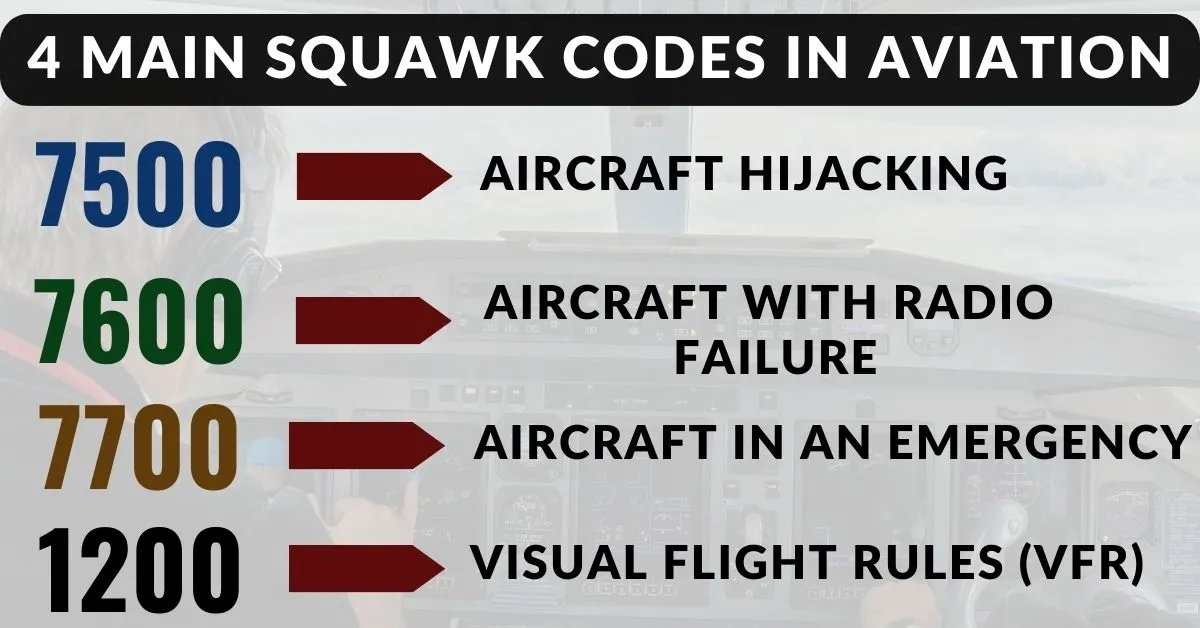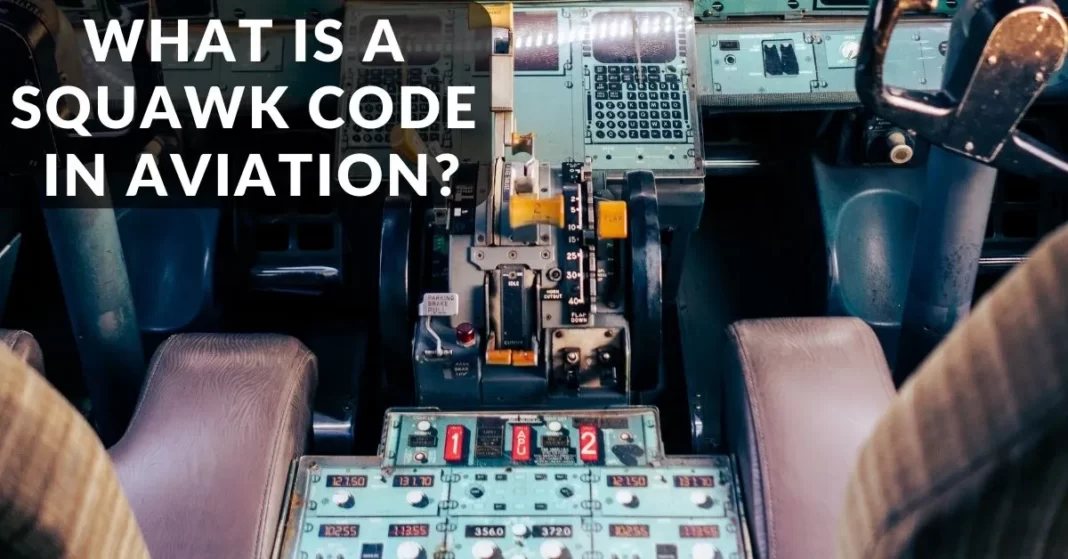As technology keeps changing how airplanes work, there’s one important thing that stays the same keeping flights safe and on track. It’s called a ‘squawk’. In the big world of airplanes, knowing about squawking and how it’s used is really important for planes to talk well with the people who help them fly.
Let’s take a closer look at what squawk means in aviation. We’ll learn about its important jobs, like having special codes that everyone understands all around the world.
We’ll also see how it’s used with something called a transponder. Most importantly, we’ll see how squawk codes help keep flying safe. So, squawk is a super important thing that helps make sure flying works the right way.
Table of Contents
Knowing What is a Squawk Code in Aviation Operations.
In aviation, “squawk” refers to a specific four-digit code provided by air traffic controllers that a pilot enters into an aircraft’s transponder.
The transponder, a radio transmitter/receiver that operates in the radar frequency range, broadcasts this code, allowing air traffic control to identify the aircraft and monitor its flight.
These squawk codes are a critical component in ensuring the safety and organization of global air traffic.
Squawk codes are divided into several categories known as “conspicuity codes.”
There are lots of possible squawk codes however, the four main codes are 7500 for hijacking, 7600 for radio failure, 7700 for emergency, and 1200 for visual flight rules (VFR).

These codes have universal recognition among air traffic controllers and pilots.
Squawking allows for seamless communication between the pilot and air traffic control to provide essential details about the aircraft’s location, trajectory, and if required, its conditions in emergencies.
The trick to remember important Squawk Codes
7500 Hijacking; Seven Five – Man with a knife
7600 Loss of communications; Seven Six I need my radio fixed
7700 Emergency; Seven Seven – I´m falling from heaven
The term squawk, in aviation, broadly refers to the specific codes that are allocated to individual aircraft during controlled flight for identification purposes.
It’s essential to understand and correctly use squawk in aviation, as it significantly increases the scrupulousness of air traffic control and enhances the safety measures of flight operations.
Understanding Squawk Codes
In simpler terms, a “squawk” is a unique four-digit code that an aircraft conveys to air traffic control radar systems.
These differentiating squawk, or transponder codes, get assigned to aircraft by air traffic controllers for swift identification and tracking of specific aircraft among the multitude visible on their radar screens. Such codes play a critical role in not only maintaining sufficient separation among aircraft for safety but also aiding air traffic controllers in effectively managing cluttered airspace.
Worldwide Recognition of Specific Emergency Squawk Codes
In aviation parlance, there exist particular squawk codes identified globally as signals of specific emergency situations on board an aircraft. These squawk codes, displayed visibly on ATC’s radar, point to various crisis events. For instance, code 7500 is an indication of a potential hijack situation, while squawk 7600 signals a loss of radio communication with the concerned aircraft.
Furthermore, the squawk code 7700 is signaled to report general emergencies on board. These unique emergency squawk codes play a crucial role in immediate recognition and prompt response to in-flight emergencies. They are universally understood and do not depend on the languages spoken by the pilots or the air traffic controllers, ensuring rapid and efficient communication during crisis situations.
Operation of Squawk and Transponder
In the realm of aviation, “squawk” is a term that designates a four-digit code emitted by an aircraft’s transponder to the radar of the air traffic control (ATC). This squawk code, assigned by the ATC, serves the purpose of uniquely identifying an aircraft within a specific ATC area.
The pilots input this code into their aircraft’s transponder, which subsequently sends out a signal incorporating this code along with other salient flight data, including altitude, to the ATC.
The significance of these squawk codes cannot be emphasized enough as they facilitate efficiently managing and regulating air traffic. These codes provide ATC with a clear and up-to-date snapshot of the aircraft’s actual position, direction, and altitude.
Understanding Squawk and Transponder Functionality
A critical component of the squawk system, the transponder is a device in an aircraft that communicates with radar signals. It reads and responds to these signals by replying with a set squawk code and altitude data. This data exchange enables detailed tracking of aircraft, proving very beneficial in busy airspace.
There are specific squawk codes communicating different situations or emergencies. For instance, 7700 conveys a general emergency, 7600 suggests a radio failure, and 7500 indicates a hijacking.
Alongside these, myriad other squawk codes represent a variety of standard operations and emergencies. With the transposer operating in various modes, such as standby, on, or altitude, they become an indispensable tool for ATC in successful aircraft navigation and control.
Importance and Uses of Squawk in Aviation Safety
The Vital Role of Squawk in Aviation Safety
The term “squawk” within aviation refers to a four-digit code. Assigned by the ATC, aircraft transponders transmit this code. Since every squawk code is unique, ATC can identify and monitor each individual aircraft effectively, contributing significantly to aviation safety.
With the help of squawk codes, ATC can prevent mid-air collisions by receiving accurate altitude data from aircraft, enabling them to maintain safe distances between planes. Squawk codes also aid in the efficient management of air traffic, particularly considering the enormous volume of aircraft operating concurrently.
Real-World Applications of Squawk Codes
One notable use of squawk codes is during emergencies. Specific codes like 7500, 7600, and 7700 signify hijacking, radio failure, and general emergencies, respectively, allowing pilots to discreetly alert ATC about abnormal situations. For instance, United Airlines Flight 93 transmitted a 7500 squawk code during the September 11 attacks.
Squawk codes have also played pivotal roles in many “close call” situations that could’ve ended disastrously. For example, in 2002, two aircraft came dangerously close to each other over the city of Chicago. Because each aircraft had its own unique squawk code, ATC was able to provide the pilots with precise directions to avoid a collision.
From an overview of squawk, recognizing specific codes, understanding the interfacing with transponders, to acknowledging squawk’s pivotal influence in aviation safety, it is evident that squawk codes are the silent heroes in the aviation industry.
They not only provide a smooth sail for aircraft flying in the massive sky, effectively managing air traffic but also quickly respond to varying emergency situations, thereby making air travel safer and more efficient.
As we continue to advance in technological developments, the reliable, time-tested system of squawk codes remains a constant, assuring an invaluable safety net for everyone involved in aviation.
What are the 3 important squawk codes?
The 3 important squawk codes are:
- 7500: This code is used to indicate that the aircraft has been hijacked.
- 7600: This code is used to indicate that the aircraft has lost communication with air traffic control (ATC).
- 7700: This code is used to indicate that the aircraft is experiencing an emergency.
These squawk codes are used by pilots to communicate with ATC in an emergency situation. When a pilot squawks one of these codes, ATC will be alerted to the situation and will take appropriate action.
What does it mean when a plane is squawking 7700?
When an aircraft transmits the emergency code 7700, it indicates that it is currently facing a critical situation. This situation could arise from various factors like a medical crisis involving passengers or crew, an onboard fire, or a mechanical malfunction.
Once a pilot enters the emergency code 7700, the Air Traffic Control (ATC) is promptly notified of the urgency and initiates appropriate measures. These measures might encompass rerouting the aircraft to the nearest suitable airport, extending support to the flight crew, and informing relevant emergency response teams.
It is crucial to understand that activating the 7700 code doesn’t automatically signify an imminent peril to the aircraft. Nonetheless, it does indicate that the flight crew is confronted with a severe circumstance, demanding immediate attention from the ATC.
Outlined below are instances illustrating when a pilot might opt to use the 7700 code:
- Medical Emergency: Should a passenger or crew member necessitate urgent medical attention, the pilot may activate the 7700 code to inform ATC and request necessary aid.
- Onboard Fire: In the event of a fire breaking out within the aircraft, the pilot could employ the 7700 code to alert ATC and seek assistance.
- Mechanical Failure: If the aircraft undergoes a mechanical breakdown, the pilot might trigger the 7700 code to apprise ATC of the situation and solicit assistance.
Watch the following video by Captain Joe where he describes Squawk Codes in an easy way.
Conclusion on ‘What is a Squawk Code in Aviation?’
Squawk codes constitute a vital component of the air traffic control system. They provide a rapid and convenient method for air traffic controllers to recognize aircraft and can additionally serve as a means to convey crucial details regarding an aircraft’s condition. A grasp of squawk codes empowers pilots and air traffic controllers to collaborate effectively, guaranteeing the secure and proficient management of airspace activities.
- Squawk codes are four-digit numbers that are transmitted by an aircraft’s transponder.
- Squawk codes are assigned by air traffic controllers to identify aircraft uniquely in a flight information region (FIR).
- Transponders are devices that transmit the aircraft’s identification and altitude to ATC.
- Squawk codes are used by ATC to track aircraft and to provide air traffic services.
- There are a number of reserved squawk codes that have specific meanings, such as 7600 for radio communication failure and 7700 for emergencies.
- Pilots can also select their own squawk codes in certain situations, such as when flying in VFR (visual flight rules) airspace.
In a nutshell, Squawk codes are an important part of aviation safety. By understanding squawk codes, pilots and air traffic controllers can work together to keep the skies safe.





